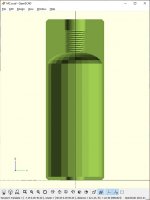I tested some moderators today. There was some problem with viewing the link IN LINE. There is no problem with viewing it if you open it via YOUTUBE. 


Last edited:
I agree, but what the average human or animal ear hears is what concerns me and although the Db differences were minimal, your moderators did sound just a bit quieter. Which makes me wonder how a tree rat, chipmunk, starling, etc hears it? (smile)Our ears don't respond to different frequencies the same way that a microphone does. The higher the frequency more difficult it is for us to hear it. That's far less true with the microphone. One of the things that happens in a moderator is that some frequencies are converted up or down depending upon the shape and volume of the moderator.
Yep, some things we need to be trained to be able to recognize. Sometime the training takes longer than we haveI agree, but what the average human or animal ear hears is what concerns me and although the Db differences were minimal, your moderators did sound just a bit quieter. Which makes me wonder how a tree rat, chipmunk, starling, etc hears it? (smile)
How other human ears hear it because I shoot in an urban environment and how my pests hear it because that may mean getting more shots when multiple targets present themselves within a short time.
Thanks for the video!
So I need to train my neighbors and the pests I shoot to not hear my airgun? LOL!Yep, some things we need to be trained to be able to recognize. Sometime the training takes longer than we have
So I need to train my neighbors and the pests I shoot to not hear my airgun? LOL!
I would be interested in further study, i.e.:Make a tight fit .177 moderator ? measure dB.
Test same gun and pellet through at .22 moderator.
Test same gun and pellet through a .25 moderator and a .30 moderator.

I made a moderator with a .22 exit , it worked nicely on .177 , not great . so i put a piece of blue painters tape 2x over the end and shot through ,it was a bit more quiet but no measurement was taken as i do not have a device and b4 app's . Now back to the question with .180 center hole or .25 center hole with .178 hole end cap ? P.S. a wadcutter cuts a fairly clean hole in painters tape .@JimNM well it would seem to me the thing to do to test that would be to make a small moderator that was hollow with different size exits what do you think?
I am happy that I am not alone in this quest. I have long been bemused that some enthusiastic people argue about the need to oversize the moderator and others insist that any extra clearance is absolutely detrimental to the reduction of sound impulse energy.
I have never seen a moderator list the inside dimensions of their bore. Without a starting point, all comparisons are baseless.
I suggested the .177 simply to maximize the sample size available. I shoot .22 and .25 with a .30 Donny moderator on the .22, and a .25 Donny on the .25 rifle. The form factor of the .30 fits the .22 rifle better and I could not detect a difference in the sound impulse between the two. I don't care at all what brand stuff is, I am only concerned with results.
Shoot'em good (and quietly)
The test has been done. There is a link to the results in the post above yours. Why do you think it is necessary to measure the bore diameter of the rifle?f somebody wishes to do this test, be sure to measure the true barrel diameter after the choke right at the muzzle. To do that accurately, you should use a pin gauge set in a go/no go scenario. It is that diameter that I then add.020" for moderator bore size. Of course, if you don't measure the barrel exit diameter, the test would not very relevant.